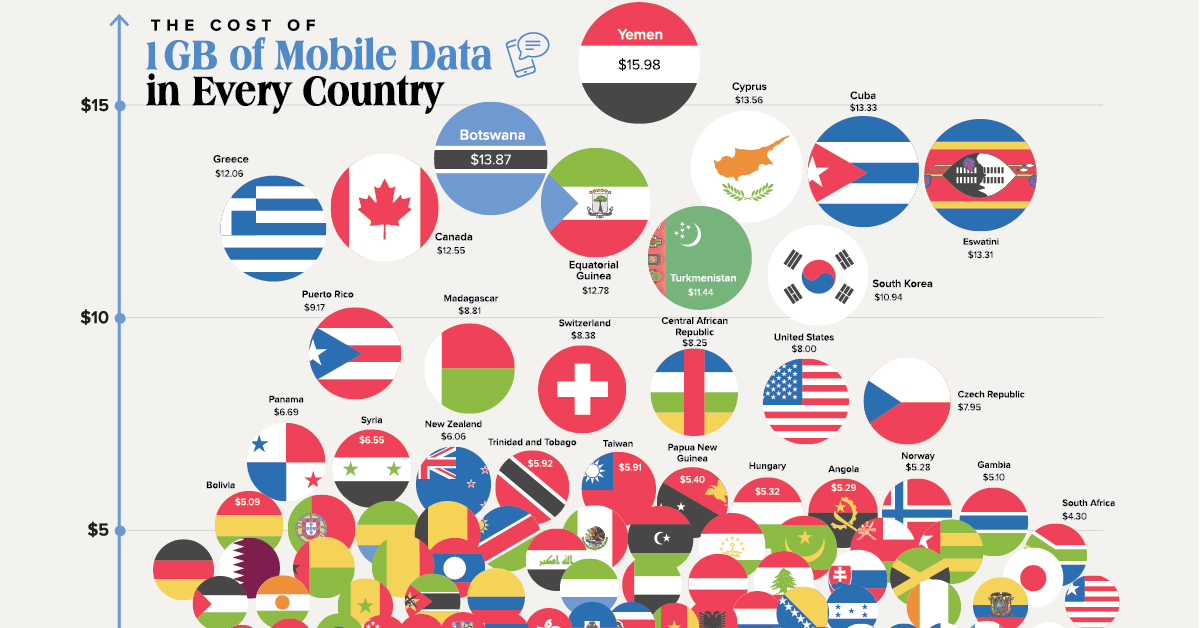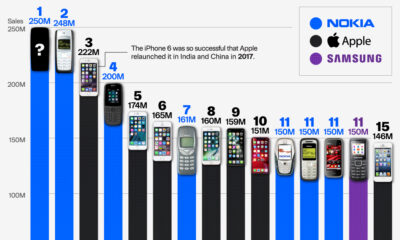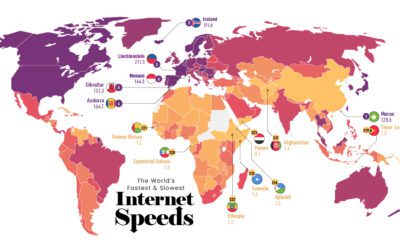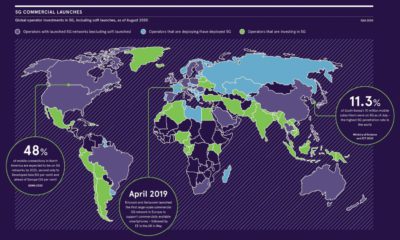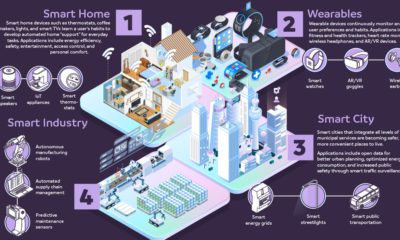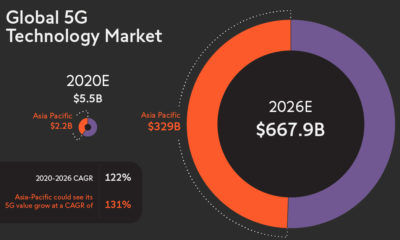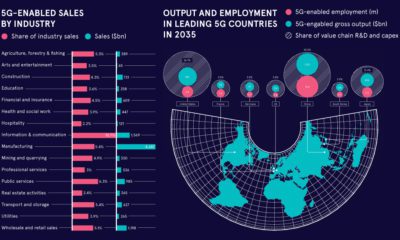Technology
What Does 1GB of Mobile Data Cost in Every Country?
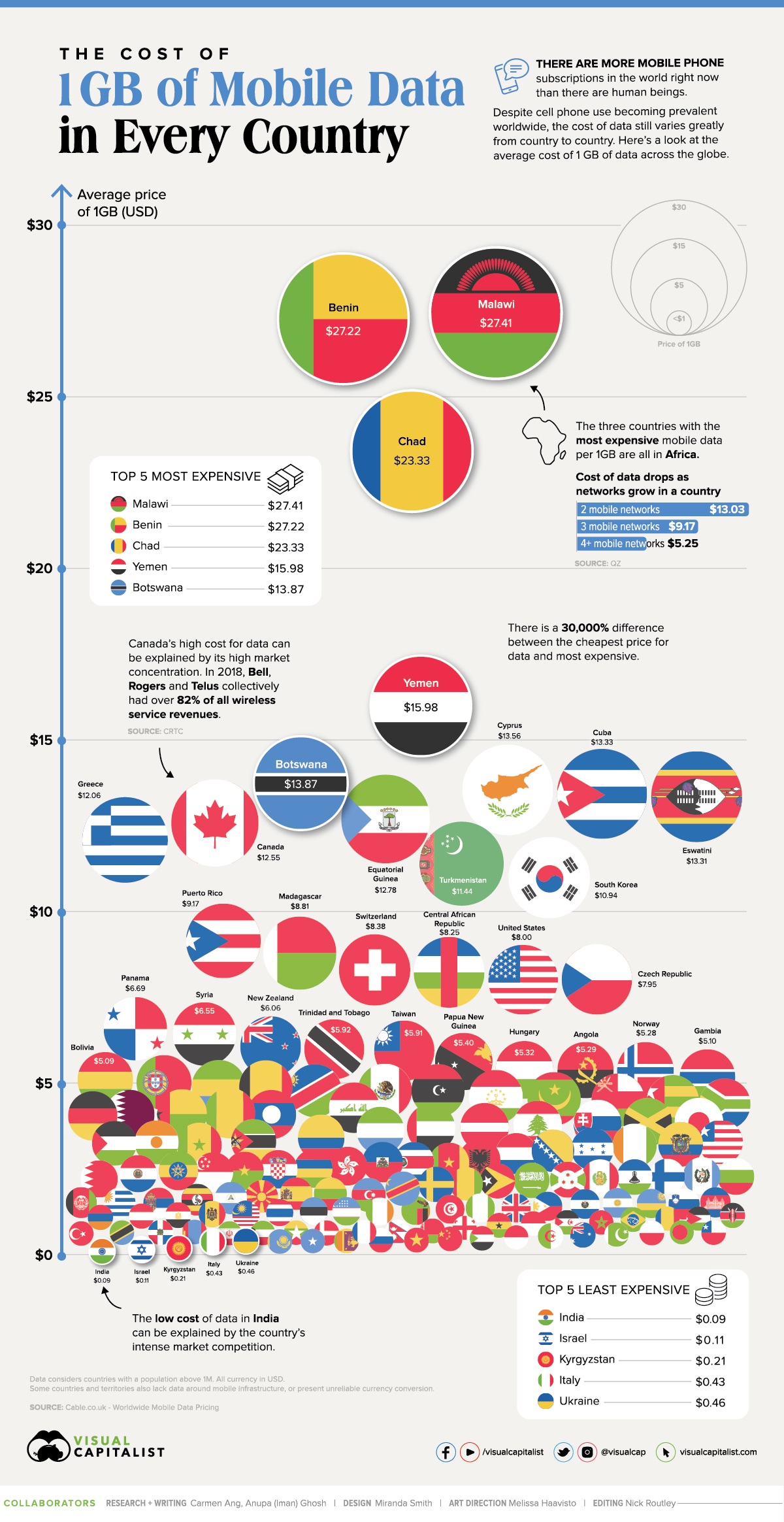
What Does 1GB of Mobile Data Cost in Every Country?
Billions of people around the world rely on their mobile phones every day.
Even in a saturated market, mobile networks have continued to expand their reach. In the last five years alone, almost one billion additional people have gained access to mobile data services.
Despite the growing prevalence of these networks worldwide, the cost of gaining access can vary greatly from country to country—particularly when it comes to the price of mobile data.
Today’s chart uses figures from Cable.co.uk to showcase the average cost of one gigabyte (GB) of mobile data in 155 different countries and jurisdictions. Despite the vast global reach of the mobile economy, it’s clear it still has a long way to go to reach true accessibility.
Discrepancies in Mobile Data Costs
Researchers have identified several key elements that help explain the cost variation for mobile data between countries:
- Existing infrastructure (or lack thereof): This might seem counterintuitive, but most mobile networks rely on a fixed-line connection. As a result, countries with existing infrastructure are able to offer mobile plans with more data, at a cheaper price. This is the case for India and Italy. Countries with minimal or no infrastructure rely on more costly connection alternatives like satellites, and the cost typically gets passed down to the consumer.
- Reliance on mobile data: When mobile data is the primary source of internet in a particular region, adoption can become nearly universal. This high demand typically leads to an increase in competing providers, which in turn lowers the cost. Kyrgyzstan is a good example of this.
- Low data consumption: Countries with poor infrastructure tend to use less data. With mobile plans that offer smaller data limits, the overall average cost per GB tends to skew higher. Countries like Malawi and Benin are examples of this phenomenon.
- Average income of consumer: Relatively wealthy nations tend to charge more for mobile services since the population can generally afford to pay more, and the cost of operating a network is higher. This is apparent in countries like Canada or Germany.
The Cheapest Countries for 1 GB of Data
Even among the cheapest countries for mobile data, the cost variation is significant. Here’s a look at the top five cheapest countries for 1 GB of data:
| Overall Rank | Country | Average price of 1GB (USD) |
|---|---|---|
| 1 | 🇮🇳 India | 9¢ |
| 2 | 🇮🇱 Israel | 11¢ |
| 3 | 🇰🇬 Kyrgyzstan | 21¢ |
| 4 | 🇮🇹 Italy | 43¢ |
| 5 | 🇺🇦 Ukraine | 46¢ |
India ranks the cheapest at $0.09 per GB, a 65% decrease in price compared to the country’s average cost in 2019.
Why is data so cheap in India? A significant factor is the country’s intense market competition, driven by Reliance Jio—a telecom company owned by Reliance Industries, one of the largest conglomerates in India. Reliance Jio launched in 2016, offering customers free trial periods and plans for less than a $1 a month. This forced other providers to drop their pricing, driving down the overall cost of data in the region.
Because these prices are likely unsustainable for the long term, India’s cheaper-than-usual prices may soon come to an end.
Another country worth highlighting is Kyrgyzstan, which ranks as the third cheapest at $0.21 per GB, ahead of Italy and Ukraine. This ranking is surprising, given the country’s minimal fixed-line infrastructure and large rural population. Researchers suspect the low cost is a result of Kyrgyzstan’s heavy reliance on mobile data as the population’s primary source of internet.
The Most Expensive Countries for 1 GB of Data
On the other end of the spectrum, here are the top five most expensive countries for one gigabyte of mobile data:
| Overall Rank | Country | Average price of 1GB (USD) |
|---|---|---|
| 155 | 🇲🇼 Malawi | $27.41 |
| 154 | 🇧🇯 Benin | $27.22 |
| 153 | 🇹🇩 Chad | $23.33 |
| 152 | 🇾🇪 Yemen | $15.98 |
| 151 | 🇧🇼 Botswana | $13.87 |
A striking trend worth noting is that four out of five of the most expensive countries for mobile data are in Sub-Saharan Africa (SSA).
A significant factor behind the high cost of data in SSA is its lack of infrastructure. With overburdened networks, the data bundles offered in the region are generally smaller. This drives up the average cost per GB when compared to countries with unlimited packages.
Another element that contributes to SSA’s high costs is its lack of market competition. In countries with multiple competing networks, such as Nigeria, the cost of data skews lower.
The Full Breakdown
The below table has a full list of all 155 countries and jurisdictions included in the data set. It helps demonstrate the stark contrast in the cost of mobile data between the most expensive and cheapest countries globally.
| Rank | Country | Average price of 1GB (USD) |
|---|---|---|
| 1 | India | 9¢ |
| 2 | Israel | 11¢ |
| 3 | Kyrgyzstan | 21¢ |
| 4 | Italy | 43¢ |
| 5 | Ukraine | 46¢ |
| 6 | Kazakhstan | 46¢ |
| 7 | Somalia | 50¢ |
| 8 | Sri Lanka | 51¢ |
| 9 | Russian Federation | 52¢ |
| 10 | Vietnam | 57¢ |
| 11 | China | 61¢ |
| 12 | Sudan | 63¢ |
| 13 | Indonesia | 64¢ |
| 14 | Algeria | 65¢ |
| 15 | Australia | 68¢ |
| 16 | Pakistan | 69¢ |
| 17 | Poland | 70¢ |
| 18 | Bangladesh | 70¢ |
| 19 | Chile | 71¢ |
| 20 | Turkey | 72¢ |
| 21 | Tanzania | 73¢ |
| 22 | Dominican Republic | 74¢ |
| 23 | Mongolia | 74¢ |
| 24 | Iran | 75¢ |
| 25 | Kuwait | 77¢ |
| 26 | Myanmar | 78¢ |
| 27 | Denmark | 80¢ |
| 28 | France | 81¢ |
| 29 | Nepal | 86¢ |
| 30 | Belarus | 89¢ |
| 31 | Georgia | 93¢ |
| 32 | Ghana | 94¢ |
| 33 | Monaco | 98¢ |
| 34 | Western Sahara | 99¢ |
| 35 | Morocco | 99¢ |
| 36 | Brazil | $1.01 |
| 37 | Romania | $1.03 |
| 38 | Jordan | $1.03 |
| 39 | Kenya | $1.05 |
| 40 | Armenia | $1.05 |
| 41 | Austria | $1.08 |
| 42 | Egypt | $1.09 |
| 43 | Moldova | $1.12 |
| 44 | Malaysia | $1.12 |
| 45 | Thailand | $1.23 |
| 46 | Estonia | $1.27 |
| 47 | Uzbekistan | $1.34 |
| 48 | Ireland | $1.36 |
| 49 | Zambia | $1.36 |
| 50 | Tunisia | $1.37 |
| 51 | Nigeria | $1.39 |
| 52 | United Kingdom | $1.39 |
| 53 | Philippines | $1.42 |
| 54 | El Salvador | $1.45 |
| 55 | Argentina | $1.45 |
| 56 | Rwanda | $1.48 |
| 57 | Slovenia | $1.48 |
| 58 | Cambodia | $1.50 |
| 59 | Afghanistan | $1.55 |
| 60 | Uruguay | $1.58 |
| 61 | Serbia | $1.60 |
| 62 | Uganda | $1.62 |
| 63 | Nicaragua | $1.71 |
| 64 | Macedonia | $1.75 |
| 65 | Spain | $1.81 |
| 66 | Lithuania | $1.85 |
| 67 | Azerbaijan | $1.86 |
| 68 | Congo | $1.94 |
| 69 | Sweden | $2.07 |
| 70 | Guinea | $2.08 |
| 71 | Timor-Leste | $2.08 |
| 72 | Saudi Arabia | $2.12 |
| 73 | Burundi | $2.12 |
| 74 | Peru | $2.13 |
| 75 | Lesotho | $2.13 |
| 76 | Finland | $2.14 |
| 77 | Guatemala | $2.17 |
| 78 | Bulgaria | $2.22 |
| 79 | Bahrain | $2.27 |
| 80 | Paraguay | $2.30 |
| 81 | Ethiopia | $2.44 |
| 82 | Singapore | $2.47 |
| 83 | Burkina Faso | $2.47 |
| 84 | Croatia | $2.48 |
| 85 | Mauritius | $2.48 |
| 86 | Hong Kong | $2.55 |
| 87 | Haiti | $2.74 |
| 88 | Costa Rica | $2.74 |
| 89 | Cameroon | $2.75 |
| 90 | Albania | $2.83 |
| 91 | Netherlands | $2.98 |
| 92 | Bosnia and Herzegovina | $3.04 |
| 93 | Honduras | $3.12 |
| 94 | Côte d'Ivoire | $3.20 |
| 95 | Ecuador | $3.24 |
| 96 | Liberia | $3.25 |
| 97 | Palestine | $3.26 |
| 98 | Niger | $3.30 |
| 99 | Senegal | $3.30 |
| 100 | Mozambique | $3.33 |
| 101 | Colombia | $3.46 |
| 102 | Sierra Leone | $3.69 |
| 103 | United Arab Emirates | $3.78 |
| 104 | Latvia | $3.79 |
| 105 | Lebanon | $3.82 |
| 106 | Slovakia | $3.84 |
| 107 | Jamaica | $3.88 |
| 108 | Japan | $3.91 |
| 109 | Germany | $4.06 |
| 110 | Qatar | $4.12 |
| 111 | Guinea-Bissau | $4.12 |
| 112 | Mali | $4.12 |
| 113 | Lao PDR | $4.16 |
| 114 | Iraq | $4.20 |
| 115 | South Africa | $4.30 |
| 116 | Togo | $4.50 |
| 117 | Oman | $4.58 |
| 118 | Mauritania | $4.63 |
| 119 | Tajikistan | $4.65 |
| 120 | Libya | $4.73 |
| 121 | Mexico | $4.77 |
| 122 | Namibia | $4.78 |
| 123 | Belgium | $4.88 |
| 124 | Gabon | $4.89 |
| 125 | Portugal | $4.97 |
| 126 | Bolivia | $5.09 |
| 127 | Gambia | $5.10 |
| 128 | Norway | $5.28 |
| 129 | Angola | $5.29 |
| 130 | Hungary | $5.32 |
| 131 | Papua New Guinea | $5.40 |
| 132 | Taiwan | $5.91 |
| 133 | Trinidad and Tobago | $5.92 |
| 134 | New Zealand | $6.06 |
| 135 | Syria | $6.55 |
| 136 | Panama | $6.69 |
| 137 | Czech Republic | $7.95 |
| 138 | United States | $8.00 |
| 139 | Central African Republic | $8.25 |
| 140 | Switzerland | $8.38 |
| 141 | Madagascar | $8.81 |
| 142 | Puerto Rico | $9.17 |
| 143 | South Korea | $10.94 |
| 144 | Turkmenistan | $11.44 |
| 145 | Greece | $12.06 |
| 146 | Canada | $12.55 |
| 147 | Equatorial Guinea | $12.78 |
| 148 | Eswatini | $13.31 |
| 149 | Cuba | $13.33 |
| 150 | Cyprus | $13.56 |
| 151 | Botswana | $13.87 |
| 152 | Yemen | $15.98 |
| 153 | Chad | $23.33 |
| 154 | Benin | $27.22 |
| 155 | Malawi | $27.41 |
Interestingly, the highest average cost is 30,000% more than the cheapest average price.
The Technology Gap
Will we reach a point of equal accessibility across the globe, or will the technology gap between countries continue to widen?
With 5G networks on the rise, just seven countries are expected to make up the majority of 5G related investments. Time will tell what this means for adoption worldwide.
Editor’s Note: The methodology used by Cable.co.uk represents a region’s national average, based on both pre-paid and post-paid plans. While the data correctly represents each region’s average cost on 1 GB based on the chosen methodology, Cable.co.uk acknowledges that it may not reflect the way most people in a country consume data.
Technology
Charting the Next Generation of Internet
In this graphic, Visual Capitalist has partnered with MSCI to explore the potential of satellite internet as the next generation of internet innovation.

Could Tomorrow’s Internet be Streamed from Space?
In 2023, 2.6 billion people could not access the internet. Today, companies worldwide are looking to innovative technology to ensure more people are online at the speed of today’s technology.
Could satellite internet provide the solution?
In collaboration with MSCI, we embarked on a journey to explore whether tomorrow’s internet could be streamed from space.
Satellite Internet’s Potential Customer Base
Millions of people live in rural communities or mobile homes, and many spend much of their lives at sea or have no fixed abode. So, they cannot access the internet simply because the technology is unavailable.
Satellite internet gives these communities access to the internet without requiring a fixed location. Consequently, the volume of people who could get online using satellite internet is significant:
| Area | Potential Subscribers |
|---|---|
| Households Without Internet Access | 600,000,000 |
| RVs | 11,000,000 |
| Recreational Boats | 8,500,000 |
| Ships | 100,000 |
| Commercial Aircraft | 25,000 |
Advances in Satellite Technology
Satellite internet is not a new concept. However, it has only recently been that roadblocks around cost and long turnaround times have been overcome.
NASA’s space shuttle, until it was retired in 2011, was the only reusable means of transporting crew and cargo into orbit. It cost over $1.5 billion and took an average of 252 days to launch and refurbish.
In stark contrast, SpaceX’s Falcon 9 can now launch objects into orbit and maintain them at a fraction of the time and cost, less than 1% of the space shuttle’s cost.
| Average Rocket Turnaround Time | Average Launch/Refurbishment Cost | |
|---|---|---|
| Falcon 9* | 21 days | < $1,000,000 |
| Space Shuttle | 252 days | $1,500,000,000 (approximately) |
Satellites are now deployed 300 miles in low Earth orbit (LEO) rather than 22,000 miles above Earth in Geostationary Orbit (GEO), previously the typical satellite deployment altitude.
What this means for the consumer is that satellite internet streamed from LEO has a latency of 40 ms, which is an optimal internet connection. Especially when compared to the 700 ms stream latency experienced with satellite internet streamed from GEO.
What Would it Take to Build a Satellite Internet?
SpaceX, the private company that operates Starlink, currently has 4,500 satellites. However, the company believes it will require 10 times this number to provide comprehensive satellite internet coverage.
Charting the number of active satellites reveals that, despite the increasing number of active satellites, many more must be launched to create a comprehensive satellite internet.
| Year | Number of Active Satellites |
|---|---|
| 2022 | 6,905 |
| 2021 | 4,800 |
| 2020 | 3,256 |
| 2019 | 2,272 |
| 2018 | 2,027 |
| 2017 | 1,778 |
| 2016 | 1,462 |
| 2015 | 1,364 |
| 2014 | 1,262 |
| 2013 | 1,187 |
Next-Generation Internet Innovation
Innovation is at the heart of the internet’s next generation, and the MSCI Next Generation Innovation Index exposes investors to companies that can take advantage of potentially disruptive technologies like satellite internet.
You can gain exposure to companies advancing access to the internet with four indexes:
- MSCI ACWI IMI Next Generation Internet Innovation Index
- MSCI World IMI Next Generation Internet Innovation 30 Index
- MSCI China All Shares IMI Next Generation Internet Innovation Index
- MSCI China A Onshore IMI Next Generation Internet Innovation Index
MSCI thematic indexes are objective, rules-based, and regularly updated to focus on specific emerging trends that could evolve.

Click here to explore the MSCI thematic indexes

-

 Technology1 week ago
Technology1 week agoCountries With the Highest Rates of Crypto Ownership
While the U.S. is a major market for cryptocurrencies, two countries surpass it in terms of their rates of crypto ownership.
-

 Technology2 weeks ago
Technology2 weeks agoMapped: The Number of AI Startups By Country
Over the past decade, thousands of AI startups have been funded worldwide. See which countries are leading the charge in this map graphic.
-

 Technology3 weeks ago
Technology3 weeks agoAll of the Grants Given by the U.S. CHIPS Act
Intel, TSMC, and more have received billions in subsidies from the U.S. CHIPS Act in 2024.
-

 Technology3 weeks ago
Technology3 weeks agoVisualizing AI Patents by Country
See which countries have been granted the most AI patents each year, from 2012 to 2022.
-

 Technology4 weeks ago
Technology4 weeks agoHow Tech Logos Have Evolved Over Time
From complete overhauls to more subtle tweaks, these tech logos have had quite a journey. Featuring: Google, Apple, and more.
-

 AI1 month ago
AI1 month agoRanked: Semiconductor Companies by Industry Revenue Share
Nvidia is coming for Intel’s crown. Samsung is losing ground. AI is transforming the space. We break down revenue for semiconductor companies.
-

 Personal Finance1 week ago
Personal Finance1 week agoVisualizing the Tax Burden of Every U.S. State
-

 Misc6 days ago
Misc6 days agoVisualized: Aircraft Carriers by Country
-

 Culture6 days ago
Culture6 days agoHow Popular Snack Brand Logos Have Changed
-

 Mining1 week ago
Mining1 week agoVisualizing Copper Production by Country in 2023
-

 Misc1 week ago
Misc1 week agoCharted: How Americans Feel About Federal Government Agencies
-

 Healthcare1 week ago
Healthcare1 week agoWhich Countries Have the Highest Infant Mortality Rates?
-

 Demographics1 week ago
Demographics1 week agoMapped: U.S. Immigrants by Region
-

 Maps1 week ago
Maps1 week agoMapped: Southeast Asia’s GDP Per Capita, by Country




